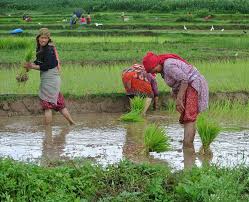Many congratulations to Ms Kim Ri Hwa for her FAO model farmer award which was presented to her last month in Bangkok.[1] Her efforts have seen a tenfold increase in rice production on the Maejon Cooperative Farm where she has helped the 80 farming families turn their lives around. That is a significant success!
Kim achieved her results by adopting Conservation Agriculture (CA), which helped restore the quality of the soil on the coastal farm she now manages in partnership with the AFSC (American Friends Service Committee). Her success is particularly well timed as sea levels are impacting dramatically upon her region and across the southeast Asian region as a whole, causing high soil salinity and devastating crop losses.
Once the integrity of the soil on Maejon Farm was re-established, the introduction of the System of Rice Intensification (SRI) helped, over a period of seven years, to increase rice yields from a paltry 1 tonne per hectare to an impressive 10 tonnes per hectare. This is an achievement not just for Ms Kim but also for SRI itself as it comes in the context of an average yield in North Korea of 5.3 tonnes/ha[2]. Even commercial farmers in the country, using all the best management practices, latest seeds and chemical inputs do not often attain such results. The introduction of other innovations at the farm has also brought about an 80% increase in maize production as well as a 70% decrease in root diseases.
SRI and CA are well-suited to environments where soil degradation and climate change represent such grave challenges.[3],[4] Both encourage eco-friendly approaches which result in healthier soils and stronger root systems in plants that are then better able to withstand strong winds, flooding, lodging and drought. CA’s no-till principle results in less compacted soil that can more easily absorb water and SRI requires up to 50% less water[5] and reduced inputs of up to 90%[6]
CA was introduced to North Korea over 15 years ago by the Food and Agriculture Organisation of the United Nations (FAO) and the AFSC has been encouraging the adoption of SRI in the country since 2004.[7] “It saves equipment, it saves fertilizer, and it also saves them labour in lots of ways. So, it really is a successful innovation,” explains AFSC’s country manager for North Korea, Linda Lewis, who believes SRI now has the potential to spread nationwide.
Kim Ri Hwa grew up in the city but embraced the world of agriculture after responding to a call for people to help develop the countryside. Hard work rewarded her with the position of team leader on a cooperative farm and she qualified as a crop engineer before managing the Maejon Cooperative Farm.
Other recipients of the model farmer award this year were Ar Promtaisong from Rayong province of Thailand, Phonexay Thammavong from Laos, Fazla Yoosuf from the Maldives and Samson Mahit Haitong from Vanuatu.
[1] http://www.fao.org/asiapacific/events/award-citations-to-fao-asia-pacific-model-farmers/model-farmers2018/en/
[2] Ireson, Randall 2013: The State of North Korean Farming: New Information from the UN Crop Assessment Report
[3] https://www.researchgate.net/publication/311418457_Conservation_Agriculture_and_Climate_Change_An_Overview
[4] Redfern, Suzanne K., Azzu , Nadine and Binamira , Jesie S. 2012 Rice in Southeast Asia: Facing Risks and Vulnerabilities to Respond to Climate Change http://www.fao.org/fileadmin/templates/agphome/documents/climate/Rice_Southeast_Asia.pdf
[5] Uphoff, N. 2007. The System of Rice Intensification (SRI) as a System of Agricultural Innovation. Paper presented at the International Workshop: Farmer Participatory Research and Development 20 Years On. Future Agricultures Consortium, Institute of Development Studies, University of Sussex, U.K. 12–14 December 2007 (available at: http://www.future-agricultures.org/farmerfirst/files/T1c_Uphoff.pdf).
[6] http://sri.ciifad.cornell.edu/aboutsri/aboutus/SRI_brochure2015.pdf
[7] https://www.afsc.org/video/improving-rice-production-north-korea-dprk


